QUALITY SEED PRODUCTION IN RIBBEDGOURD
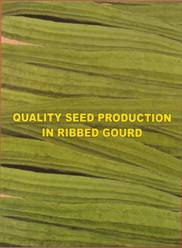
Introduction
Ribbedgourd is cultivated in large extent in South and Eastern states. It is rich in vitamin. A, potassium, phosphorus and calcium. Non-availability of quality seed is one of the constraints in this crop cultivation in large area. In ribbedgourd, we can get 13-14% seed recovery.
Land selection
The selection of land is the first and foremost task for a seed producer. The seed production plot must be selected carefully. A fertile and healthy seed plot will certainly produce' quality seed. The field selected for seed production must not have been sown with ribbedgourd in the previous season. This is done to avoid volunteer plants that cause admixture.
Soil with neutral pH must be selected. Loam or clay loam soils are best suited. Higher organic matter will lead to production of vigorous seed.
What are volunteers?
Volunteers are plants that grow in the field from the seeds found in the soil. These seeds should have been fallen from previous season crop. As they germinate without sowing or they volunteer to grow by themselves, hence the name volunteer plants.
Isolating the seed crop to avoid genetic contamination
Genetic purity can be maintained by preventing cross pollination with other undesirable varieties. This is achieved by isolating the seed crop.
Isolation is the act of growing the seed crop away from a contaminant such that cross pollination is prevented. Ribbedgourd is a highly cross pollinated crop because flowering is monoecious in nature. Hence it requires 500 m (1500 feet) isolation away from another variety of ribbedgourd.
Selecting the right season for raising seed crop
Seed is very sensitive to weather. Hence selecting the right season is necessary. Though ribbedgourd can grow through out the year, seed crop should be grown such that the seed matures in cool dry climate. This will facilitate proper ripening of fruits and reduce the pest and disease infection. In Tamil Nadu the best seed crop growing seasons are Aadi and Thai Pattam i.e. June-July and January- February
Seed selection
"Well begun is half done" so goes the saying, selecting ripe and vigorous seed is the first step in the production of robust seedling which will ultimately lead to producing quality seed. Planting robust seedling will impart disease and pest resistance and help in proper uptake of precious fertilizer applied to the main field. Proper care must be taken to avoid the usage of aged seeds, stored for more than an year.
Selection of seeds is the first step in production of quality seed. This involves selection of seeds with the right genetic make-up of the variety chosen to be produced. Seeds must be from an approved source. This is possible if the seed is got from the breeding firm / University research station or from the breeder himself. Verify if the seed brought has breeder seed tag (for producing foundation seed); foundation seed tag (for production of certified seed). Further, the seeds must be free from pest and diseases. Rotten dull coloured, black spotted seeds must be removed. Seeds of uniform size and shape alone must be used for sowing.
Preparation of main field and sowing
After proper ploughing, at a spacing of 2.5 x 2 m distance take pits having 45 cm length, width and height. Ten days after that, apply 10 kg FYM and urea 20 g, super phosphate 90 g and potash 15 g per pit. Then mix the above nutrients with soil and fill the pits and level them. Since, it is vining in nature better to erect the pandal at 2 m height. It will facilitate for better growth and yield and also easy for roguing operation.
Sowing
Seed required for an acre (1 kg/ acre) may be treated with fungicides before sowing. Then five seeds may be sown in a pit at equal distance.
Irrigation management
After sowing pits should be irrigated with water cane. Care must be taken that the soil should not be eroded and seed should not be exposed. After the seedling emergence, field should be irrigated once in a week.
Main field maintenance
Ten days after the germination, retain three vigourous seedlings per pit and remove two seedlings. So that it will facilitate for better growth of seedling without any competition between them. 20-25 days after sowing, each plant has to be provided with stacking for training the vines over the pandal. Training operation has to be carried out daily until the fruiting stage.
Controlling weed
Maintaining the field free of weed is more important for the crop growth. In ribbed gourd, one or two manual weeding is necessary before the flowering stage.
Growth regulator spray
Generally in cucurbitaceous vegetables, the male and female flowers are born separately. The number of female flowers decides the fruit yield. Hence, for ribbed gourd, spraying of ethrel at 250 ppm for four times starting from 15 days after sowing and followed by weekly intervals (i.e. 2.5 ml of ethrel in 10 lit of water). This facilitates higher fruit yield.
Top dressing
Seed crop is entirely different from vegetable crop. Hence, fertilizer is applied as two or three split doses. Two split doses of urea as 22g/pit at flowering stage and another 18 g urea plus 5 g potash / pit each at 20 and 40 days after flowering. This leads to higher fruit bearing, higher fruit retention and quality seed yield.
Plant protection
Maintaining plant health is more important and hence prophylactic plant protection measure should be taken. To control leaf cutting beetles and fruit flies and borers spray Malathion 50 EC 1 ml or Dimethioate 30 EC 1 ml or Fenthion 100 EC 1 ml/lit of water.
Powdery mildew: Spray carbendazim 0.5 g or Dinocob 1 ml/lit of water.
Maintaining seed quality by rouging
One of the most important aspects of seed production is thorough roguing. Rogue is defined as the plant that deviates from the characters described for the variety. Such rogues if left in the field they tend to reduce the genetic purity of the seed crop and thus reduce purchase value of resultant seed. Roguing is defined as the operation of removing rogues. In practice, air virus infected plants are to be removed.
When to do roguing?
Roguing is more effective if done prior to flowering, since upon flowering there is very high possibility of cross pollination. Roguing is also attempted during vegetative phase, fruit formation stage and prior to harvest.
Roguing during vegetative phase
During vegetative phase, during first 30-35 days, roguing is attempted based on plant characters like height of plant, leaf shape, size, surface of leaf. Plants showing heavy branching and spreading nature are removed. Plants showing variation in stem or leaf base colour are also removed. Those plants showing symptoms of yellow mosaic are also removed.
Roguing during pod formation phase
At this phase, the rogues are removed based on fruit characteristics like length of fruit, size, shape and colour.
Roguing during pod harvest phase
Roguing is done prior to harvest based on fruit colour and pest and diseases infection. While harvesting separate infected fruits from good ones and forward only the uninfected fruits for seed extraction.
Caution!
All the rogues must be immediately removed from the seed field and destroyed.
Harvest
The change of pod colour to brown is the indicator for harvest in ribbedgourd seed crop. At that stage the seed posses higher vigour and viability. Once there is a symptom of hair line cracks on the edges of the pod, it should be harvested without any delay.
The harvests will be done in different pickings in ribbedgourd. Here the first and last one or two harvests may be taken for vegetable.
For seed purpose generally harvest will be done 7-10 days after the maturity of vegetables. Since, at that stage the seeds will attain its maturity. At that stage, there will be change in fruit colour to brown. After the harvest the fruits can be dried for one or two days for easy seed extraction. Fruits confirming the genetic purity with medium to large size fruits should alone be used for seed extraction. This selection and grading procedures will increase the yield of quality seed recovery.
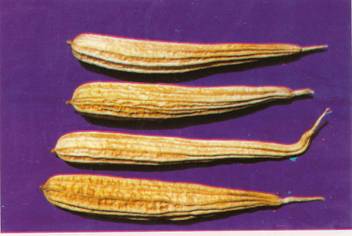
Fruits selected for seed extraction
Processing to improve seed quality
After the pod harvest and before the seed extraction, only healthy pods of true to type and free from pest/ disease infestation are to be selected for seed extraction.
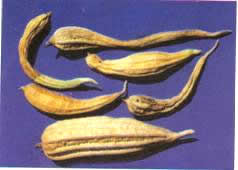
Removal of small and other variety fruits
Seed extraction method
The selected pods are to be dried for one or two days before seed extraction. Seed extraction is easy in ribbedgourd. For seed extraction cut open or make holes at the distal end of the pod and separate the seeds easily. Separated seeds are to be pre-cleaned manually by removing the white and pale yellow coloured ill filled seeds.
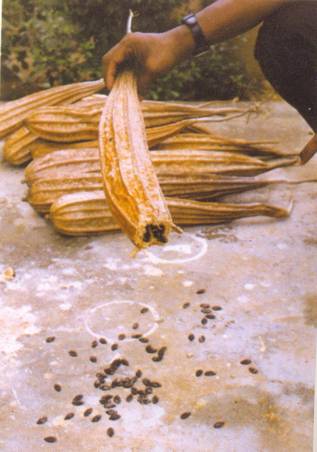
Seed extraction
And then the seeds are to be processed with 16/64" round perforated metal sieve or BSS 4 wire mesh sieve.
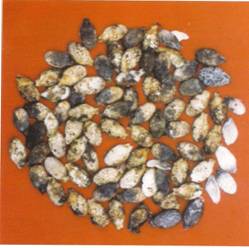
Illfilled seeds
Drying seeds to reduce moisture
Seeds extracted by the above method have a moisture content of 12-13% and have to be dried before storage. The seeds are dried by spreading them over a tarpaulin for 8-10 hrs under partial shade. This is followed by sun drying where the seeds are dried between 8-12 am and 3-5 pm only. Drying during the hot hours of 12-3 pm will lead to seed damage caused by higher temperature and presence of UV radiation in sunlight.
Seed cleaning and processing
After proper drying seeds have to be processed. By removing the ill filled and small size seeds, the vigour and viability could be improved. For ribbed gourd seed processing BSS 4 wire mesh sieve is to be used. After sieving, those seeds that are broken, fungal infected, seed coat damaged seeds are removed.
Caution!
While using wire mesh or round holed sieves, be through in cleaning the sieves. Any remnant of previous crop seed will lead to contamination. Seeds generally get struck in the holes and have to be removed before commencing the sieving operation
Protecting seeds during storage
Producing quality seeds is only half of the job, the other half is protecting the seed during its storage that starts after processing till it is sown by the farmer. The major aspects that impart good storability are safe seed moisture, seed treatment, mid storage correction and seed storage container.
Seed moisture
Seed moisture is the foremost seed physical attribute that contributes for storage life. Lower the seed moisture, longer the shelf life. Short term storage can be achieved by drying the seeds to 6-7% moisture content while long term storage is possible by reducing the seed moisture even further to 6%. Under such low moisture content, seeds have to be stored in moisture proof bags made of thick polythene (700guage).
Seed treatment
Prior to storage, seeds are treated with fungicide to ward off fungal pathogens. Seeds are mixed with Carbendazim 4g/kg. A novel technique called Halogen permeation treatment is also recommended now-a-days. Calcium oxy-chloride , commercially known as bleaching powder and powdered calcium carbonate (lime stone) are mixed in equal ratio. This mixture is added to seed at 5g / kg and stored.
Seed container
Apart from seed and seed treatment, the next most important aspect of seed storage is seed container. Container can be chiefly differentiated as moisture pervious and moisture impervious types. Cloth, paper, gunny bags are moisture pervious as the moisture from outside atmosphere can enter and exit freely. Hence, even if the seed is dried to safe moisture, but stored in a humid climate, then seed gains moisture during storage and looses vigour. So, to safely store seeds in moisture pervious bag, the outside humidity must be low. In Tamil Nadu, most of the months are hot and humid, hence after drying the seed to safe moisture limit, seeds can be safely stored in moisture vapour proof containers like thick polythene bag of 700g or in tin / plastic containers that are sealed tightly. In case of short term storage (4-6 months) cloth or gunny will be sufficient.
Seed certification
Seed certification guarantees the quality of seed as it ensures that the certified seed has the genetic, physical, physiological and seed health qualities. Genetic purity means that the seed gives rise to a plant which conforms to the varietal characteristics of the variety. The physical purity means that the seed is free from stones, broken seeds, straw bits and leaf bits etc. Physiological quality is measured by germination and seed health envisages freedom from pest and diseases.
Seed certification is being done in many stages. It starts from verifying whether seeds were obtained from authenticated source, verification of isolation distance and inspection during plant growth, flowering, harvesting, processing and bagging. Also seed samples are drawn form the seed lot and sent to seed testing lab to test whether the seeds are possessing required physical purity and germination. Then certification tag is issued. Colour of the tag is blue for certified seeds.
Only those seeds harvested from fields having prescribed field standards and possessing required seed standards are certified by the Certification Agency. Seeds thus certified are offered for sales. For further details nearer seed certification office may be contacted.
Minimum seed certification standards prescribed for certified seed
Field standards |
|
Rogues (maximum limit) |
0.2% |
Seed standards |
|
Pure seeds (minimum limit) |
98.0% |
Inert matter (maximum limit). |
2.0% |
Other crop seeds (maximum limit) |
None |
Weed seeds (maximum limit) |
None |
Germination (minimum limit) |
60.0% |
Moisture content |
|
Moisture proof bag |
7.0% |
Moisture pervious bag. |
8.0% |
|





